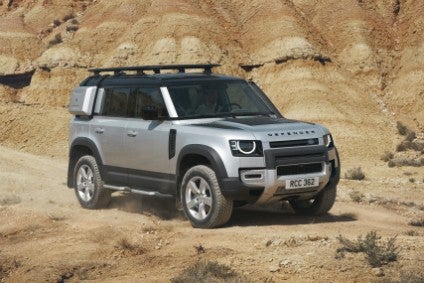
To celebrate the launch of Jaguar Land Rover's gleaming new design centre in Gaydon, the British firm invited us to an exhibition of its latest vehicles and technologies.
Front and centre was the new 2020 Land Rover Defender. This model is the reinvention of an icon that went largely unchanged during its near-70-year production run but, while its background might be steeped in heritage, the replacement still manages to break new ground.
First production vehicle with a plastic wrap
In a room devoted to the new Defender's materials and construction sat a display featuring paint samples and a few pieces of seemingly unremarkable plastic. However, closer inspection led by engineers from Land Rover's colours and materials team revealed that this plastic was actually essential to achieving some of the new Defender's most eye-catching finishes.
The plastic was, in fact, a multi-layer polyurethane-based wrap that Land Rover applies on the production line. The 2020 Defender is the first-ever production vehicle to feature this technology – dubbed a Satin Protective Film – from the factory, and its use reflects Land Rover's expectation that Defenders will be used in tougher conditions than other models in its range. It's only available on models finished in Indus Silver, Gondwana Stone and Pangea Green and serves a number of functional purposes.
Immediately obvious is its aesthetic effect – the wrap has a slightly translucent finish and, when applied over gloss paint, reflects light in a diffuse pattern to give the whole car a satin sheen. Satin and matte-finish paints are nothing new but they are hard to own because overzealous cleaning and polishing can cause them to become glossy – defeating their original purpose. Land Rover's wrap eliminates this problem because the plastic can be washed as normal without any risk of losing its satin finish.
Enhanced off-road protection…
More useful to owners than the looks will be the level of protection the wrap brings. Being an off-road vehicle means the Defender will be subject to more than its fair share of scrapes and scratches from rocks and plants – not to mention errant trolleys in the supermarket car park. Thanks to the wrap's self-healing properties, scratches and scuffs on the bodywork can be fixed with a hairdryer, hot water, or even just the sun's energy – simply applying heat to the scratched area causes the material to flatten out and return to normal.

US Tariffs are shifting - will you react or anticipate?
Don’t let policy changes catch you off guard. Stay proactive with real-time data and expert analysis.
By GlobalDataThe material is applied by hand on the production line by skilled technicians in a process that takes a number of hours to complete. Considering this is the first-ever production application of this technology, Land Rover acknowledges that this process will probably become quicker as it refines its methods. Should the owner decide that they want to change the look of their vehicle later on, they are able to peel the wrap off and return to a regular glossy paint finish.
…and sustainable
With more emphasis on the sustainability of materials, and the impact of humanity's over-reliance on plastics becoming more evident, introducing large amounts of plastic into the production process could be seen as a risk – both from an environmental and marketing perspective. However, Land Rover assures us that the wrap is sustainable, solvent free and fully recyclable. In fact, the brand claims that replacing the wrap is more environmentally sound than repainting a damaged panel.
The wrap features on a vehicle that already makes remarkable use of materials – for example, Land Rover's colours and materials team were particularly proud of the structural magnesium beam that runs behind the dashboard. Rather than completely hide it behind plastic cladding, the team decided to expose the ends of the beam and form them into grab handles – making it both a structural element and a tactile touch point for passengers.



